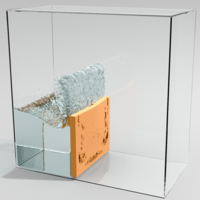Particle Merging-and-Splitting

|
Robustly handling collisions between individual particles in a large particle-based simulation has been a challenging problem. We introduce particle merging-and-splitting, a simple scheme for robustly handling collisions between particles that prevents inter-penetrations of separate objects without introducing numerical instabilities. This scheme merges colliding particles at the beginning of the time-step and then splits them at the end of the time-step. Thus, collisions last for the duration of a time-step, allowing neighboring particles of the colliding particles to influence each other. We show that our merging-and-splitting method is effective in robustly handling collisions and avoiding penetrations in particle-based simulations. We also show how our merging-and-splitting approach can be used for coupling different simulation systems using different and otherwise incompatible integrators. We present simulation tests involving complex solid-fluid interactions, including solid fractures generated by fluid interactions. |
[Project Website]
[DOI/EE link]
[Preprint on arXiv.org]
@article{TYWLK21,
author = {Nghia Truong and Cem Yuksel and Chakrit Watcharopas and Joshua A. Levine and Robert M. Kirby},
day = {30},
ee = {http://dx.doi.org/10.1109/TVCG.2021.3093776},
journal = {{{IEEE} Trans. on Visualization and Computer Graphics}},
month = {6},
number = {12},
pages = {4546--4557},
title = {Particle Merging-and-Splitting},
volume = {28},
year = {2021}
}